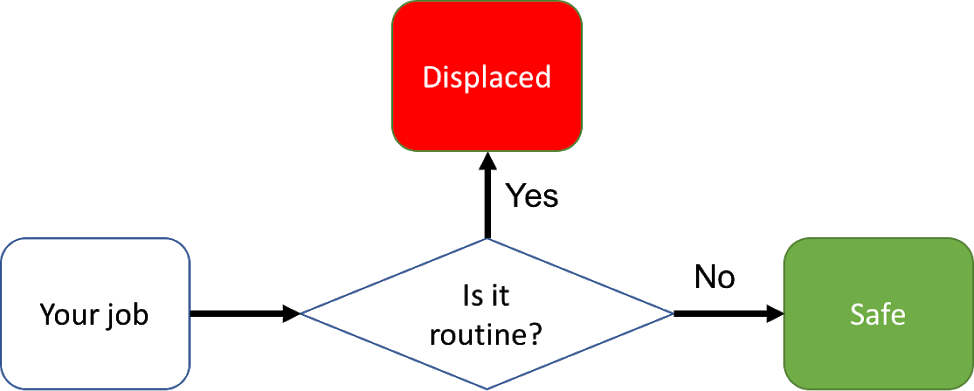Transitioning into a future system
The exponential growth of synthetic intelligence has resulted in intense discussions on the future of work. Hod Lidson’s article highlights that exponential rates of change are difficult for the human mind to comprehend and for the eye to see. Exponential curves are unique in the sense that they are mathematically self-similar at every point. What this means is that an ever-doubling curve has no flat part, no ascending part, and none of the elbow and hockey stick bends many business people are used to talking about.
There is a school of thought that projects a future in which robots take jobs from human workers and another in which automation may create more jobs than it displaces. In the former, displacement is not new but the rate of displacement is. The type of jobs that will be displaced typically fall under the ‘routine’ category, i.e., predictable work that is done repetitively (see Figure 1). Examples of such roles are administrative staff, manual workers and data processing jobs. In the latter, the type of jobs created will probably look a little different and it will certainly require a varied range of skill sets.

While new jobs are being created, we are of the belief that technology should empower existing jobs and through this assistive process, some degree of knowledge transfer takes place. This form of capability-building is especially important as we are transitioning into a future system where the contours and parameters are not yet clear.
A mental model to ease the transition
One mental model that has been useful relates to that of systemisation and automation (see Figure 2). A system is a process made explicit and repeatable. Systemisation is the act of creating a new system. The primary benefit of creating a System is that you can examine the process and make improvements. Figure 2a depicts a scenario where a System is created and improvements have been made allowing a vertical move from 0 to 1.
Automation refers to a system or process that can operate without human intervention and is best for repetitive, well-defined tasks. The less human intervention, the more efficient the Automation. Figure 2b depicts a scenario where after making improvements to the System, some repetitive processes have been automated allowing a horizontal move from 1 to 2. With a new System in place, the process can be examined and after further improvements, another vertical move, from 2 to 3, can be realised (see Figure 2c)*.
*This can also be viewed as a structured abstraction of a Kaizen event that couple’s technological considerations

If we were to factor in the new economic restructuring, we need to speak about using the right technology as an enabler and how it will lead to a more progressive economy. The first rule of any technology used in a business is that automation applied to an efficient operation will magnify the efficiency. The second is that automation applied to an inefficient operation will magnify the inefficiency [Bill Gates].
At The Intelligent Warehouse, we understand the impact of transformation and how to accelerate your innovation cycle. With the commoditisation of technology and the levelling of the playing field, we need to maintain the impetus to perform, the latitude to be creative and the motivation to contribute to the common cause.
Let’s work together.
If you see the need to transition into a future system, do reach out for a chat at [email protected]